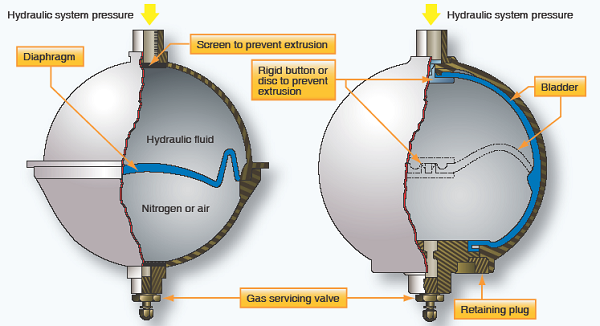Related Resources: calculators
Accumulator Capacity Formula and Calculator
Hydraulic and Pneumatic Design and Engineering
Fluids Engineering and Design
Accumulator Capacity Formula and Calculator
The accumulator is a steel sphere divided into two chambers by a synthetic rubber diaphragm. The upper chamber contains fluid at system pressure, while the lower chamber is charged with nitrogen or air. Cylindrical types are also used in high-pressure hydraulic systems. Many aircraft have several accumulators in the hydraulic system. There may be a main system accumulator and an emergency system accumulator. There may also be auxiliary accumulators located in various sub-systems.

Figure 1. A spherical accumulator with diaphragm (left) and bladder (right). The dotted lines in the right drawing depict the bladder when the accumulator is charged with both hydraulic system fluid and nitrogen preload.
The function of an accumulator is to:
- Dampen pressure surges in fluid system caused by actuation of a unit and the effort of flow demand or the pump to maintain pressure at a preset level.
- Aid or supplement the power pump when several units are operating at once by supplying extra power from its accumulated, or stored, power.
- Store power for the limited operation of a hydraulic unit when the pump is not operating.
- Supply fluid under pressure to compensate for small internal or external (not desired) leaks that would cause the system to cycle continuously by action of the pressure switches continually kicking in.
Eq. 1
V = BC ( Pp / Pf - Pp / Ps )
Where:
BC = Accumulator Container Volume per capacity (gallons)
Pp = Pre-charge Pressure (psi)
Ps = System Pressure (psi)
Pf = Final Pressure (psi)
V = Accumulator Capacity (gallon)
Source:
Reference: Lapeyrouse, N. J., 2002, Formulas and Calculations for Drilling, Production and Workover, Second Edition, Gulf Professional Publishing, Page: 39.
Related
- Fluid Hydrualic Accumulator Review Application and equations
- Hydraulic Accumulator Sizing Equations and Calculator
- Spring Type Fluid Accumulator - General Design
- Water Hammer Accumulator Sizing Excel Spreadsheet Calculator
- Hydraulic Cylinder Piston Velocity Speed at which the piston rod of a hydraulic cylinder moves is based on the following equation:
- Basic Hydraulic Fixed Displacement Pump and Accumulator Closed Center System Schematic Fixed Displacement Pump and Accumulator Closed-Center System
- Bag Type Fluid Accumulator - General Design Consists of a seamless high-pressure shell, cylindrical in shape, with domed ends and a synthetic rubber bag
- Fluid Accumulator - General Application Hydraulic accumulator is a pressure storage reservoir in which a non-compressible hydraulic fluid